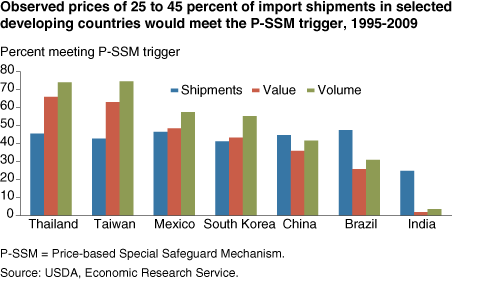Potential Developing Country Agricultural Safeguards in Cereal Grains Markets
- by Amanda Leister
- 6/5/2012
Increased concerns regarding food access around the world have spurred a number of countries to introduce agricultural policies aimed at insulating domestic markets from price variability in world commodity markets. These same concerns underlie ongoing negotiations in the World Trade Organization (WTO) under the Doha Development Agenda over provisions for a Special Safeguard Mechanism (SSM). This mechanism would allow developing countries to impose additional duties if imports of agricultural commodities increase above a specified quantity trigger or import prices fall below a reference price trigger. If approved, the SSM is expected to increase domestic commodity prices in the developing countries where the policy is implemented. The SSM is also expected to increase the volatility of world commodity prices if the measure is widely used by developing countries.
ERS examined trade in seven developing countries (Mexico, South Korea, Taiwan, Brazil, China, Thailand, and India) to determine what would have been the frequency and intensity for price- and quantity-based SSMs for cereal grains between 1995 and 2009. Frequency is measured as the ratio of total shipments meeting the trigger for the price-based SSM to total shipments traded. Intensity (of the price-based SSM only) is measured by calculating the maximum duty that could have been applied to each shipment relative to the global average price of the commodity.
The price-based SSM could have affected between 25 percent (India) and 45 percent (other countries) of shipments. Frequency and intensity results vary by import region and commodity market. Findings suggest that price-based SSM duties may be more likely to be triggered against grain exports from developing countries and that relatively high permissible price-based SSM duties could have been levied on developing country exporters as well as shipments comprising relatively small trade flows, which are often sourced from developing countries. Results from the quantity-based SSM are not as uniform across import markets when compared with results from the price-based SSM regime. However, 10 percent of cereal grain shipments, accounting for slightly more than 5 percent of cereal grain trade volume, would have exceeded the threshold level of imports to trigger the quantity-based SSM. The evidence suggests that there is potential for both the quantity- and price-based SSM to be triggered in major grain markets in developing countries, thereby affecting agricultural trade with developing countries.
This article is drawn from:
- 'Potential Frequency and Intensity of the Special Safeguard Mechanism'. (2011). African Technology Development Forum. 8(1/2): 54-65.


